
The world according to David Graham
Displaying the most recent stories under presentations...
City Council decision on the Hanlon upgrades
It was a long night in Council's new chambers last night. The session lasted a full six hours, which I suspect gave most people the impression by the end that thy had always met in that room, even though it was the first meeting there since new City Hall opened. On the agenda was the construction of a new organic waste processing facility, upgrades to the Hanlon, approval of budgeting for money under a $135.5 million Infrastructure Stimulus Fund, and other topics that were ultimately deferred.
On the organic waste plant, also known as the 'wet plant,' several impassioned local residents rose to demand a full environmental assessment be done of the $26 million facility's construction. The small rural neighbourhood nearby the facility on the outskirts of town reported that the last, rather unsuccessful, such plant resulted in the deaths of four of the local residents from aneurisms as air and water quality were allegedly tainted by the facility.
Ultimately the new plant was approved by council without an EA and that project will be going forward over the next few years. I found it interesting in the lengthly discussion on this item that the City currently sends 8 trucks per week of organic waste to a Niagara Falls, New York incinerator to be burned. It perplexes me that so much of our waste leaves by truck when waste is by no means a high priority commodity, and the so-called "Waste Resource Innovation Centre", or our trash collection facility, is right next to the city-owned Guelph Junction Railway, albeit separated by a narrow river. Eight truckloads of trash is around two freight car loads of trash. Part of the plans for the new wet facility also include importing wet waste from nearby municipalities to process, which will also be done by truck. Were we to build a small rail spur into the Waste Resource Innovation Centre, we could both import and export our trash by rail at minimal environmental and economical impact rather than moving all the trash by truck, a vehicle designed for priority.
On the agenda, there was also another curious item: Guelph's distribution of money from the Infrastructure Stimulus Fund. It breaks down like this:
- Organics Waste Processing Facility - $26.5 million
- Guelph Transit Terminal, Bridge Rehabilitation and Related Road works - $16.4 million
- Eastview Community Park and Pollinator Initiative - $7 million
- Civic Square Skating Rink/Water feature - $2 million
- Municipal Facility Rehabilitation, Energy Conservation Upgrades and Accessibility Improvements - $10.3 million
- Major and Minor Road Reconstruction - $17.1 million
- Norfolk: Norwich to Quebec Road Reconstruction - $5.4 million
- Sidewalk Rehabilitation - $3 million
- Parks Rehabilitation - $3.8 million
- Road Reconstruction Projects - $24.9 million
- Road Pavement Deficit - $5 million
- City Bridge and Structure Upgrades - $2.1 million
- New Sidewalk and Bicycle Lane Construction - $2.5 million
- Intersection Improvements - $6.2 million
- Storm Water Infrastructure - $2.3 million
- Railway Crossings - $1 million.
Road investment (6, 7, 10, 11, 12, 14) $60.7 million
Walking/cycling investment (8, 13): $5.5 million
Transit/rail investment (2, 16): $17.4 million
That is $17.4 million for transit and rail projects, and $60.7 million for roads -- and that's counting rail/road crossing upgrades for rail. The $16.4 million for a Guelph Transit Terminal raises another whole host of issues, not least of which is that there is no evidence yet that Via Rail has actually agreed to have its station parking lot ripped out and turned into a bus/train interchange terminal. Even if it is, because Council elected not to save the Lafarge property as a park-and-ride, the project will devastate downtown parking no matter how many $30-$50,000/stall parking lots we build.
Anyway, in the context of all that happening, Council's other major decision last night was weather or not to support the Ministry of Transport of Ontario's recommendation to upgrade the Hanlon between Maltby Rd and Wellington.
Here is the text of my comments to Council on the topic:
Madam mayor, members of council,
What is our global vision for transportation?
While the Hanlon was being built in the early 1970s, the prevailing attitude was that any problem could be solved with another hunk of pavement. In 1974, while the Hanlon was under construction, a survey conducted by the City of Guelph asked industries, essentially: can you move away from trains and switch to trucks so that we can abandon most of the profitable Guelph Junction Railway? Surely our attitude has improved since that time.
The Hanlon was built to allow Guelph residents to bypass the downtown. Before the last section was even finished, Guelph had a save-the-downtown committee. This lesson is one we are continuing to fail to learn. The Hanlon already allows motorists to bypass Guelph's commercial centre, but its main purpose is to connect the different parts of Guelph to each other. Chopping out College and Claire, and making Kortright's Guelph-side access a residential service road, turns the Hanlon from an intra-Guelph highway to a Guelph bypass.
As importantly, we don't even know what the MTO has in store for the other half of the Hanlon, but we do know the highway is eventually intended to connect to Highway 6 south of Morriston, new Highway 7 north of Guelph, and we can safely assume it will connect to the GTA West project which still pretends to be something other than a highway project. These upgrades are not a project by, about, or for Guelph, but about finding a way around Guelph.
While the proposal before you went through extensive public consultation, the question asked was always: how should we upgrade the Hanlon. It was never: should we upgrade the Hanlon. It was never: where do we want to be in 20 years? We have no global vision for transportation.
If we go ahead and upgrade the Hanlon, we will see increased traffic volumes with better flow, pat ourselves on the back, and congratulate ourselves for planning for the future. If we do not, we will see increased congestion, and we will regret not doing the work. Why? Because that is the shallow view of the world we take, where highways are the answer but nobody knows the question.
There are four major highway projects currently ongoing in the vicinity of Guelph, of which the resolution before you covers only one quarter of one. If we divert the hundreds of millions of dollars of our money these highway projects will cost to mass transit, and give people a useful way to get around, we may start making headway.
Most of us probably drove to this meeting tonight. I, frankly, would rather not have. But parking downtown is free. Taking the bus, round trip, is $5, and takes approximately five times as long as driving, plus waiting. In all likelihood, the last bus will have left before I leave this meeting tonight. Counting generously, one out of every twenty trips in this city is done on a bus, and we are proud of the "five percent modal share" busses enjoy. We call it our goal, and we sleep well at night knowing that only ninety percent of people use their cars exclusively.
This evening's resolution includes a request to study further transit opportunities, but it does not go far enough. These have been studied over and over; what we need is actual investment in improved mass transportation opportunities for both passenger and freight, as part of a global vision for transportation that sets out how, not whether, we will move toward mass transit over the next decades.
While passenger trains have been largely relegated to the status of quaint tourist attraction, railway tracks parallel the Hanlon and Highway 6 from Guelph to Hamilton, where they continue parallel to the QEW all the way to the US border. Abandoned railway lines parallel Highway 6 north of Guelph all the way to Owen Sound. There is no reason for us not to invest in moving our people and goods on these economical, environmental railway lines, rather than once again upgrading our highways. These are just some of the options we can evaluate, but applying more band-aids to our highways should not be among them.
The auto industry does not have the money to fight transit projects at the moment. This is the time, as US President Barack Obama has figured out, to invest in mass transit, rather than highways. The Hanlon's time to upgrade has come and gone. Now is not the time to build bigger better overpasses at taxpayer expense, it is the time to come up with alternatives so that all of us can come to council meetings by public transit if we choose, with a reasonable expectation of being able to get home after, for less than the cost of driving.
Madam mayor and members of council, while the Hanlon was built forty years ago, the decision of whether to think like forty years ago or think about forty years from now rests in your hands for this small corner of the world. Do not approve this highway project until we have planned what we are really doing with transportation, not only to get us to the year 2031, but for the indefinite future, as time will not stop when our highways and our city reach their planned capacity.
I appeal to you to show the leadership that is needed in these times to formulate and implement our part of a true global vision for transportation.
Thank you.
Following my presentation, Councillor Piper asked me to expand on the construction cost difference between road and rail. I pointed out that Highway 7 will cost in the order of $30 million per kilometre to build, while rebuilding an abandoned railway line costs approximately $1M/km in each of parts and labour.
After hearing delegations for more than two hours, some in favour, more opposed, all with one problem or another with the plan, it was approved in a disappointing 12-1 vote, paving the way for one more albatross around the City of Guelph's neck and leaving me and many others scratching our heads about the vision our leadership claims to have.
guelph
presentations
transit
1697
words - whole entry and permanent link. Posted at 13:20 on
April 28, 2009
Guelph-Horizon Hydro merger debate
Tonight, Guelph City Council is holding a meeting mostly to discuss a proposed merger between Guelph Hydro and Horizon Hydro, the company formed out of the merger of Hamilton and St. Catharines Hydros. Below is my statement as a delegation to council this evening on the topic.
Madam mayor, members of council,
I come to you as a citizen concerned about some aspects of the proposed Hydro merger. Any time someone tries to sell me an amazing deal that expires if I don't act now, I get just a bit wary. So I have a few questions. Why the rush? Are the reasons for the rush substantiated? Is bigger always better? And what, exactly, are these economies of scale we keep hearing about?
There is an inherent contradiction in all we are being told. On the one hand, Hydro's board tells us that if we don't do this merger, we risk being merged against our wishes at a later date in less favourable circumstances. On the other hand, we are told that this merger needs to be approved before the tax holiday window slams shut in October. In between is the statement that the Ontario government is looking to reduce the number of local distribution companies to around 10 from the hundred-odd we have now, a claim for which there is not a shred of evidence.
If councillor Wetstein is right that Guelph Hydro will be merged eventually, and it is best to do it while we are in a position of strength, and if the Ontario government is serious about wanting mergers, then at some point, if we have a truly excellent merger proposition, and a sense as a community that it is the right thing to do, we can take it to the Ontario government and ask for this tax exemption at that time. If they are not willing to give it to us, then we can safely assume that the province is not, in fact, serious about promoting the merger of utilities. It is worth pointing out that Guelph Hydro achieved this position of strength on its own, not as part of any MegaHydro.
If councillor Laidlaw is right, and small local utilities are the way of the future, then we have to ask ourselves what we accomplish by even considering merging. Is it a business case or is it a community case? Is this proposal to help us save a few dollars in the short term, or is it to help us build a better community?
The BDR consultants last week asked us to give different values weights, and also suggested that we have to ask ourselves if we consider Guelph Hydro a business that can be sold or an essential service like our police or fire services. Those two points are inextricably connected. It goes without saying that both our police and fire services are inherently dependent on Guelph Hydro, as is every other aspect of our community.
What are these economies of scale we keep hearing about that a merged -- but not interconnected -- utility would provide? Will we need fewer power lines, transformers, and transfer stations, or will we get a bulk rate discount from Guelph Utility Pole? Surely the 30 or so employees that we would cut between the two utilities will not add up to the much touted and unproven 20% savings we are told of over the next few years. If they do, I wish I had one of those evidently very lucrative jobs.
While we are looking at numbers, what is the line between transactions that require shareholder approval, and ones that do not? Why is this threshold not public?
I believe that all of us have more questions than answers. Have we considered some kind of strategic partnership, something that we can get out of? Why would we merge with another city's utility when that city - Hamilton - would retain a 59% stake, able to buy and merge with as many small companies as it pleases without any input or veto from Guelph? I recommend we take BDR's advice and assess values to each consideration ourselves. We should value our utility as an essential service, not as a business, and consider it in terms of our community first.
Thank you for your continued leadership.
guelph
presentations
722
words - whole entry and permanent link. Posted at 00:00 on
July 21, 2008
Stop paving over my generation!
This is my response to the Ministry of Transport of Ontario's Environmental Assessment report, to be delivered to the Guelph Community Developlent and Environmental Services (CDES) committee this morning.
Members of council,

I ask that you symbolically decline to receive the MTO's Environmental Assessment on this highway project. The 50 million dollar-plus upgrades to the south half of the Hanlon are an unconscionable waste of money. The people of Ontario are crying out for better mass transit, yet we continue to let them down by putting the money into our highways.
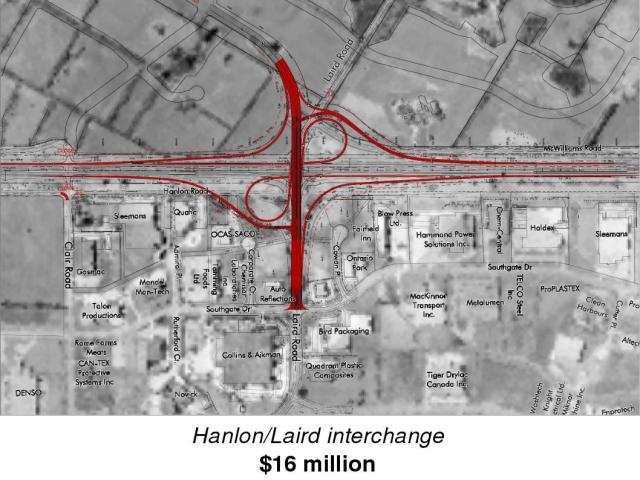
I am not addressing the logistics of which interchanges we are closing and which residential streets we are planning to clog to marginally raise the speed limit for people to bypass Guelph on the Hanlon. No, my concern is the fact that we are doing this upgrade at all.
Mass transit service is in short supply everywhere. GO Transit can hardly keep up with its demand. As fast as it expands, its parking lots and its trains fill. Yet the province is diverting 3.4 billion dollars for new highways across the province, with half a billion dollars for our highways here in and around Guelph, instead of to meaningful mass transit infrastructure. How far would $50 million go given to Guelph Transit? How long will $50 million for 4 new interchanges last before we need to expand the highway to 6 lanes? And then to 8 lanes? And then to add a collector? How much expansion and how many lanes is too much? How much highway can we maintain? It is time to draw the line on highway expansion. We have to call what we have now the limit at which we will pave no further.
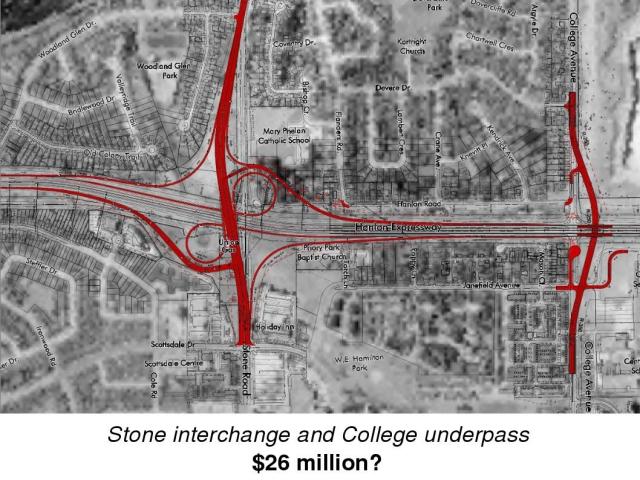
People, by and large, do not want to be in their cars. They use them because our transit alternatives are utterly inadequate. But, because we use cars, we put all our investment money into roads to accommodate them, at the expense of better, more environmental and economical alternatives. Spending money on transit will, quite simply, save money. Transit systems are cheaper to build and maintain than highway networks and use under-capacity railway lines rather than over-capacity highways. Building transit gives drivers an alternative to the highways, one that they are not shy to use.
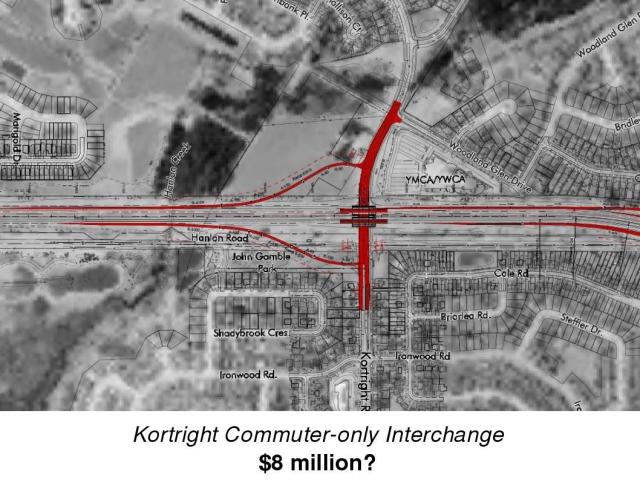
For just a few local examples:
- The new GO Transit Aberfoyle park-and-ride facility is reported to be exceeding all expectations, even though it connects only to a GO Bus;
- The Georgetown line has 4 huge GO park-and-ride stations in the last 13 miles between Georgetown and Bramalea. Two of those four stations already have full overflow parking lots every working day. The newest, Mount Pleasant station, was built only two years ago to accommodate ever-growing demand.
- Barrie introduced GO service in December and it took them only 2 months to fill their 480-car lot. Those are 480 cars in each direction that no longer use the highways every single day. This number is limited only by the lack of further parking at their Barrie station, a clear warning for Guelph as we anticipate the imminent arrival of GO trains ourselves.
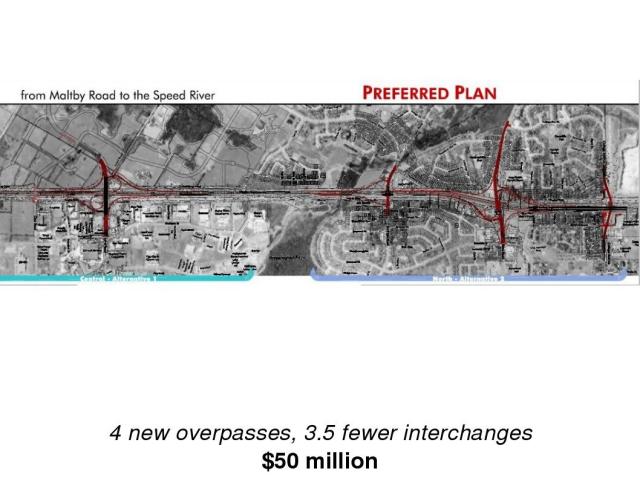
People clearly want our investment to be in mass transit. They are showing it with their actions all over southern Ontario. We are not building our transit infrastructure fast enough even to keep up.
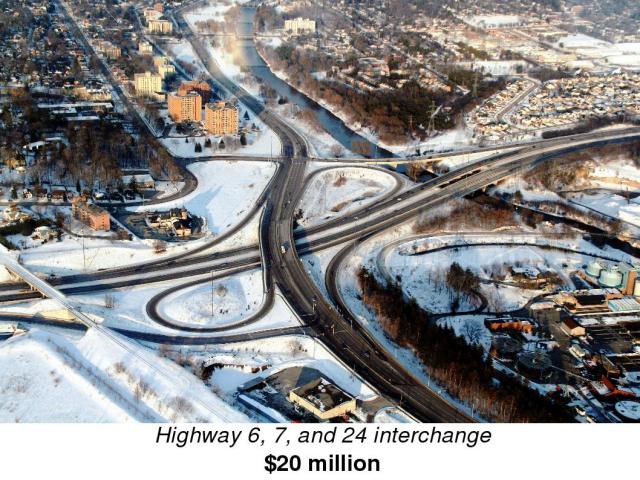
Our priorities are all wrong. Highways are a colossal waste of money. If we put the amount of money we put into our highway systems into our rail systems instead, we would no longer need to upgrade our highways. When we reach adequate rail service, when getting in our cars to go further than the grocery store is as alien a concept to us as getting on a bus is now, that is the time to reexamine our highway capacity. We may well find that what we have is sufficient to handle the remaining traffic that simply cannot go by rail. It is our only way out of the highway construction and urban sprawl death spirals that we are currently enduring.
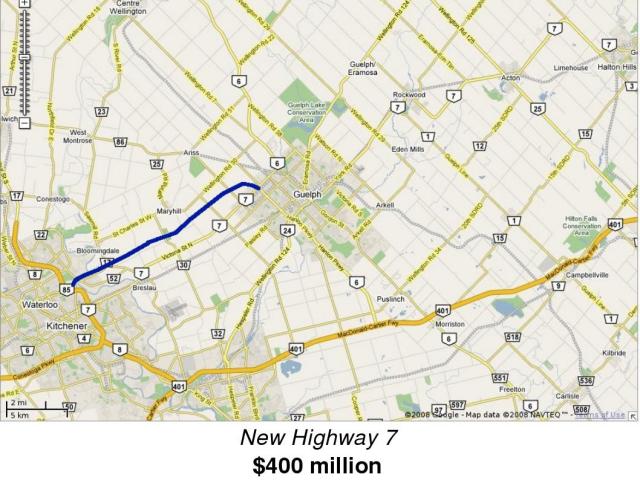
There are approximately 120 thousand people in Guelph. These Hanlon upgrades, for just four interchanges, are estimated to cost approximately $50 million. That is 416 dollars for, or rather from, every man, woman, and child in the City of Guelph. Could we not do just a little bit better for that money?
It is not only for commuters and car drivers that we need to take this into consideration. This project plans to spend 16 million dollars to build an interchange at Laird and Hanlon to accommodate trucks in our new Hanlon Creek Business Park. What would it cost for us to connect that industrial park to the city-owned railway system instead, or at minimum, as well? If we are to consider this, the current plans must be reworked to accommodate railway tracks under, or over, the Hanlon from the Guelph Junction Railway to the east to both the old and the new Hanlon Business Parks which straddle the Hanlon.
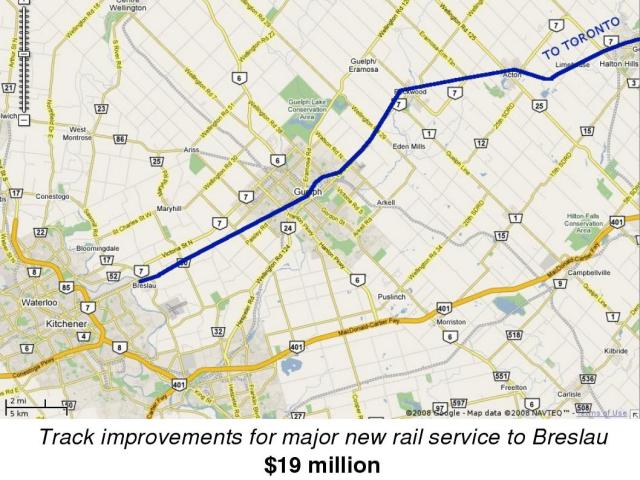
Highways lead to more cars, and cars lead to more highways. It is only too late to correct our plans once the shovels are in the ground. I urge you, the members of this committee, to continue showing leadership in these matters. We need your leadership. Send the MTO packing on the highway 6 upgrades. They are wasteful and they are misguided. This money -- our money, whichever level of government spends it -- would be much better invested in real, viable, new, mass transit systems, diverting traffic from our tension-causing, lung-wrecking, traffic-clogged roads. These billions, invested properly, would give us the best transit system in the world. It is what the people are truly crying out for with their actions, if not with their words.
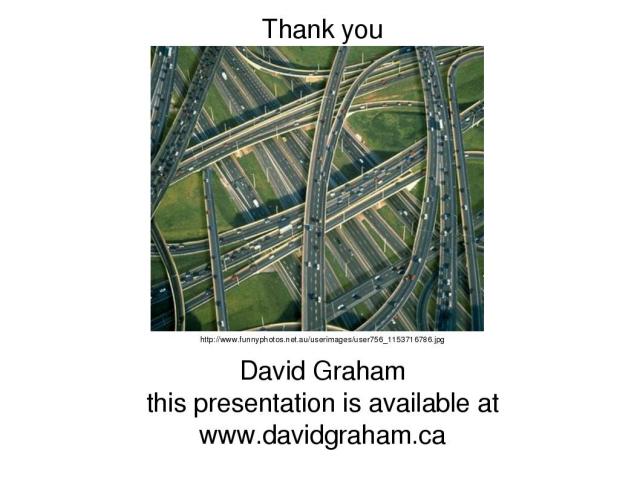
Thank you.
guelph
highways
presentations
transit
972
words - whole entry and permanent link. Posted at 14:30 on
March 07, 2008
Guelph city council presentation on the former Lafarge Lands planning application
This is the text and slides of the presentation I plan to make tonight to Guelph City Council regarding the former Lafarge lands of which I have written about before. I will update this post when I get home. It promises to be a late night - I am second of at least 22 delegations presenting. You can watch the whole meeting live, here or on cable channel 20 in Guelph.
Madam mayor, members of council,
A brief history
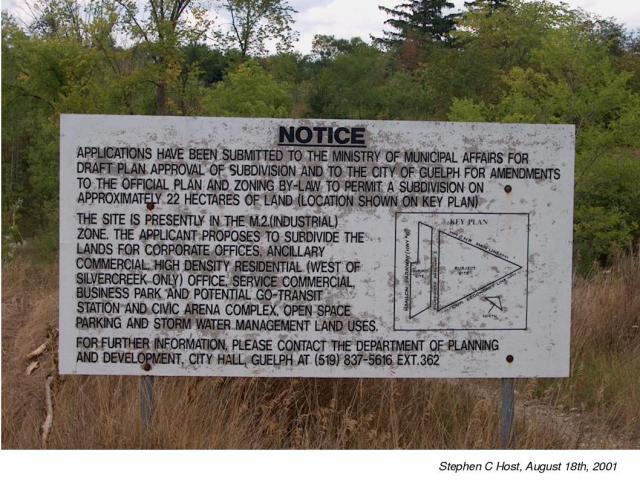
It seems, once again, history is repeating itself.
On January 15th, 1990, the federal government gutted passenger service in Canada, cutting Via service by 55%. Via service in Guelph was reduced from 10 trains a day to just 4. Three years later, in 1993, the cash strapped provincial government cancelled GO train service to Barrie and to Guelph. Around that time, the former Lafarge property was the subject of a development application. Later, in 2001, a friend of mine snapped this photograph of their application notice on that property.
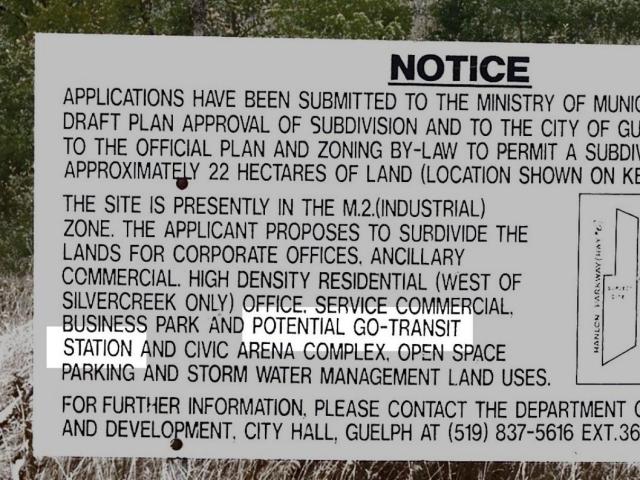
It reads, in part:
"... The applicant proposes to subdivide the lands for corporate offices, ancillary commercial, high density residential office, service commercial, business park, and potential GO-Transit station", among other things. These plans eventually quietly died, but times have changed, and now, a new developer wants to work with this plot of land. It is my hope that the community and the developer can work together to address the issues I and the other delegations here tonight will address.
Intro
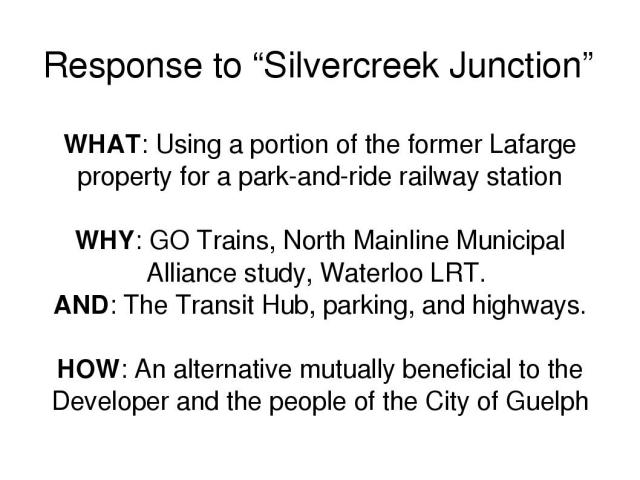
I want to talk to you today about a few key considerations when debating the application before you. Primarily, I wish to express my hope that a portion of the former Lafarge property can be set aside for a park-and-ride train station, a theme that transcends all aspects of my presentation. Coupled with the looming transit hub, no commuter and no traveller will be left behind as GO trains, Budd cars (self-propelled passenger coaches), and Light Rail Transit systems slowly begin to dominate our regional transit network, the arrival of which I will briefly touch on. I plan to suggest alternatives to the current development proposal that will be beneficial to both Guelph and the developers of this land.
The point
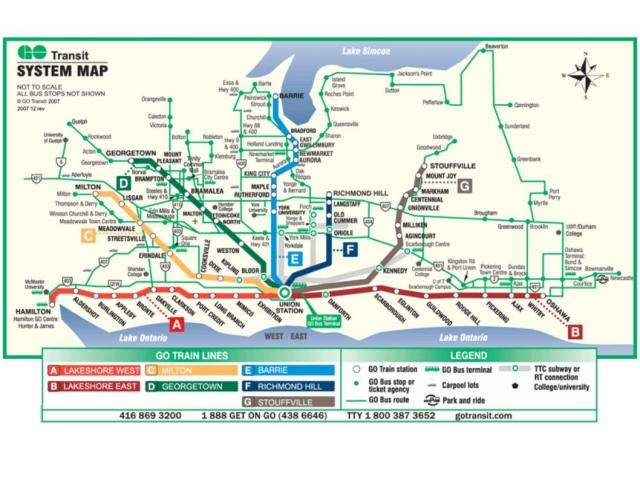
GO Transit restored GO train service to Barrie in December of 2007 after a 14-year hiatus, providing 4 trains each way for what GO anticipated to be 150 passengers. On its first day of operations, 280 cars were counted by local residents in the GO station parking lot. Just prior to that event, GO Transit's board of directors voted in favour of starting an Environmental Assessment to return GO train service to Guelph and beyond. The province, meanwhile, is changing the rules on Environmental Assessments for transit projects to cap them at 6 months, expected to be law by June, meaning we could have GO service to Guelph very soon.
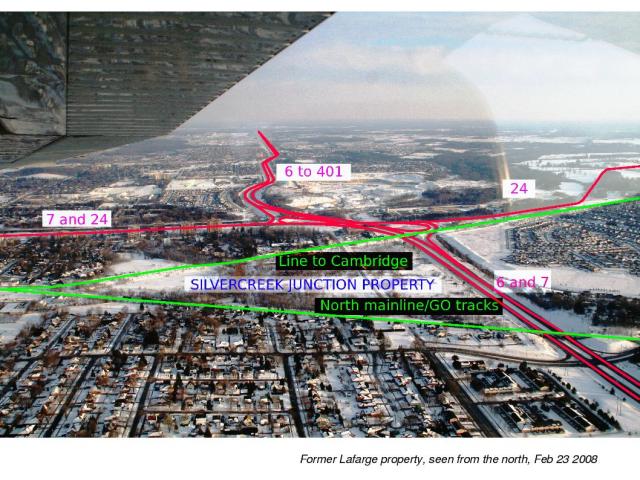
Seen here in a photo we took just one week ago, the former Lafarge property, ironically called Silvercreek Junction by a developer that, for the moment, sees the rail lines as a liability rather than as an asset, exists next to the junction of 3 highways - 6, 24, and 7 - and 2 railway lines - the North Mainline, connecting Toronto to London via Georgetown, and a branchline connecting Guelph to Cambridge.
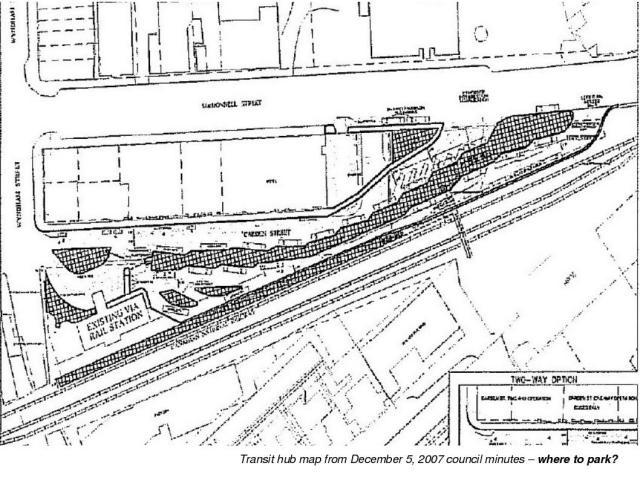
With Guelph proposing to turn the Via and Greyhound stations downtown into a multi-modal transit hub -- next year -- commuter train passenger parking will be reduced from the approximately 50 parking spots that now exist in Via's ever-overflowing lot for the one rush hour Via train we have, to zero parking spaces. A transit hub with no available parking will have a very limited effect on the majority of our suburban commuters. The former Lafarge property, a 22 hectare piece of land at this prime, accessible location, will be required for Guelph's much-needed park-and-ride railway station.
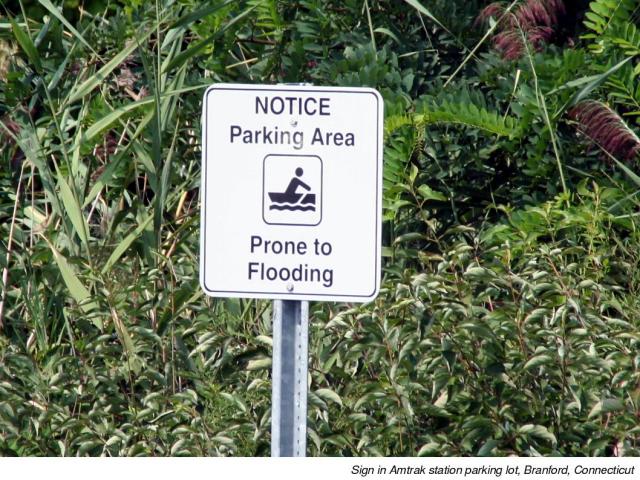
The developer's proposal for a park between the creek and the rail junction is sensible - there isn't a whole lot else that can be done with that particular plot of land, if it is set aside as a flood plain.
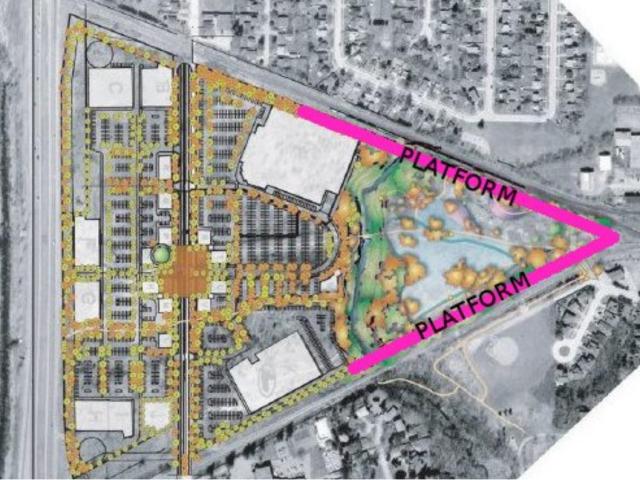
I would, however, request that an allowance be made for a platform capable of accommodating a 12-car GO train along the tracks on the north side of the property. Room should also be left for a smaller platform connected to it along the track on the south side of the land. Both platforms should be planned to be two-track platforms. The access between the two tracks on each platform could also potentially solve the problem of park users safely crossing the tracks.
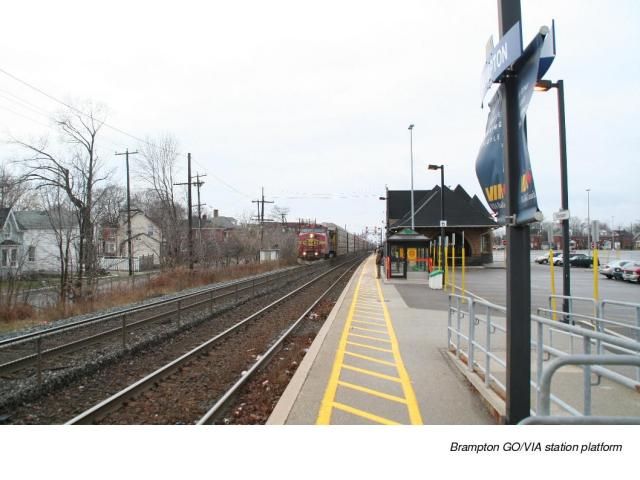
My real concern is quite simple. If we do not save a portion of the Lafarge lands for a GO station, Guelph will either be deprived of a park-and-ride station altogether, forcing drivers to travel either to Acton or Breslau to board the commuter trains, or more likely to just hop on the 401 and go to work by car, or one will be built at an inconvenient or highly unpopular location.
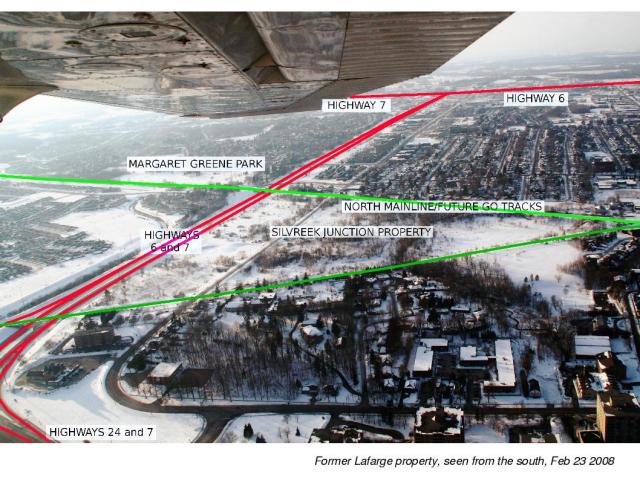
A quick look at a map shows one other location large enough for a substantial parking lot that is near both the three highways and the North Mainline within the City of Guelph, but I am quite certain there would be a revolution if Margaret Greene Park were to be converted into Margaret Greene Parking Lot. It would be a tragedy to flatten and pave a greenfield when a brownfield had been available.
Alternatives such as the West End Recreactional Centre are neither close to highways, nor home to anywhere near sufficient parking for a commuter train station, with just 300 parking spaces available. Other options would likely involve building a station in the area between Watson Road and Jones Baseline, diverting all the Hanlon GO commuter traffic through downtown, and out the east end of the city, a trek that would likely keep a good number of commuters merrily travelling the 401. It is these drivers heading for the 401 to whom we need to give a reason to turn around and take the train.
Other transit considerations
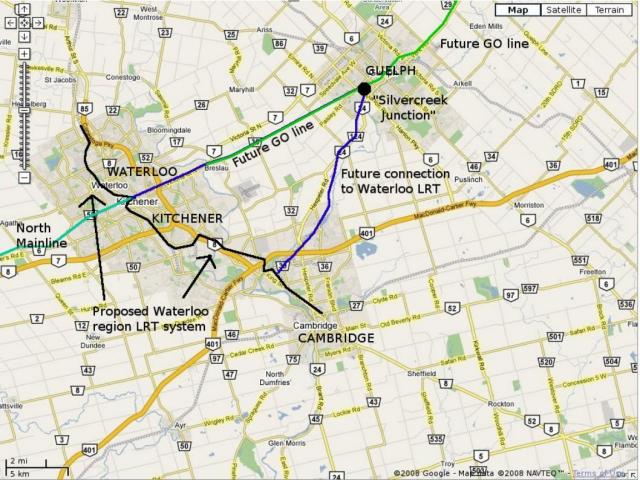
It is important to note two other developments in rail transit in our immediate area. The first is Waterloo region's push for an internal Light Rail Transit line, which I recently suggested we lobby for Guelph to connect to. The second is the North Mainline Municipal Alliance's 2006 business case study showing the economics of building inter-city rail service using self-propelled Budd cars along the North Mainline. The park-and-ride station I am proposing would be a valuable asset for that inter-city service for the same reason as it would be important to GO service. Parking would be available, and people travelling in all directions, not only toward Toronto, would be able to make use of such a station.
The construction of such a railway station in no way precludes Silvercreek Guelph Developments Limited, or any other developer, from developing this land. A park-and-ride station would require only a portion of it.
Places to Grow and Alternative Plans
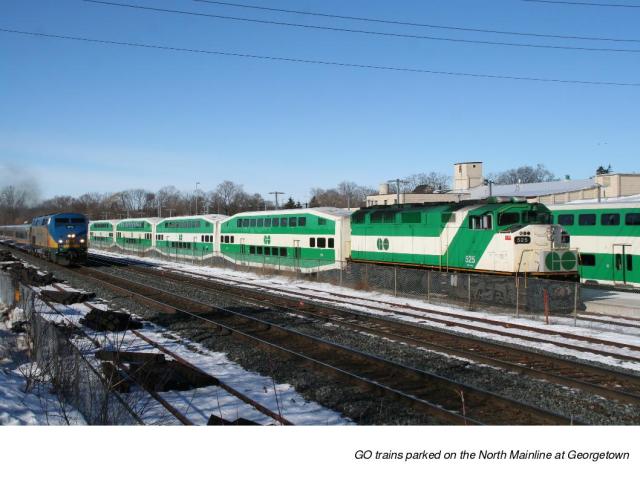
Nobody should expect the developers of this property to make any concessions out of the kindness of their hearts. In order to change their minds and their plans, they have to be shown something that is better for them as well as for the community.
The province's Places to Grow legislation demands that we increase our population to nearly unsustainable levels with intensified residential development. Targeting the Lafarge property for high-rise condos marketed primarily to commuters who want to walk to work in other cities from Guelph via the train would be both lucrative for the developers and beneficial to the community.
These commuters are coming to Guelph regardless. Giving them a place to live where they can exit the city every morning without compounding our traffic problems, rather than pushing them to ever further suburbs, would strike me as being at least somewhat intuitive, and also lends well to the much touted principle of a walkable community. To that end, a commercial strip could also be built as part of the development to accommodate every commuter's dream: a coffee shop between home and the train station, perhaps under an oak tree.
Conclusion
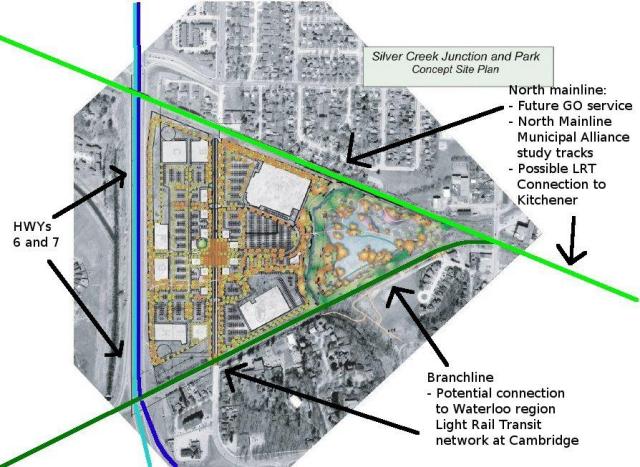
We are the ones on the ground here in Guelph, and we must prepare the groundwork for the arrival of our transit future. It is imperative that we take the initiative and take advantage of the transit expansion around us to help Guelph become a better connected city of the future. As clearly seen on this plan proposed by the developer, with the North Mainline bordering along the length of the property on the north side, and a secondary railway line along the length of the property on the south side, we have a significant opportunity here and now to make these needed preparations. I trust you as members of council, the stewards of our community, to continue working toward this goal.
At the end of the day, GO trains will be passing this property, and we will not be able to stick out our thumbs to ask for a ride. I strongly recommend that the current planning application for "Silvercreek Junction" be improved prior to its acceptance by the City to accommodate this reality. The developers have shown some interest in doing what is right with their effort to create a market square and to save the property's large oak tree, and I look forward to the improvements they will make based on what they are hearing here tonight.
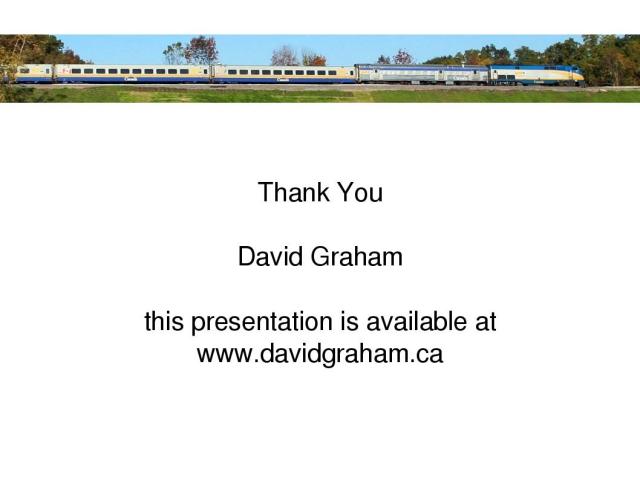
Thank you.
guelph
presentations
transit
tv
1607
words - whole entry and permanent link. Posted at 00:00 on
March 03, 2008
Guelph official plan city council presentation
Tonight, my wife and I presented to Guelph City Council in its chambers on the topic of Guelph's official plan. This is the text of my speech interlaced with the powerpoint slides.
For reference, this was my first speech since my Bar Mitzvah in 1994!
Madam mayor, members of council,
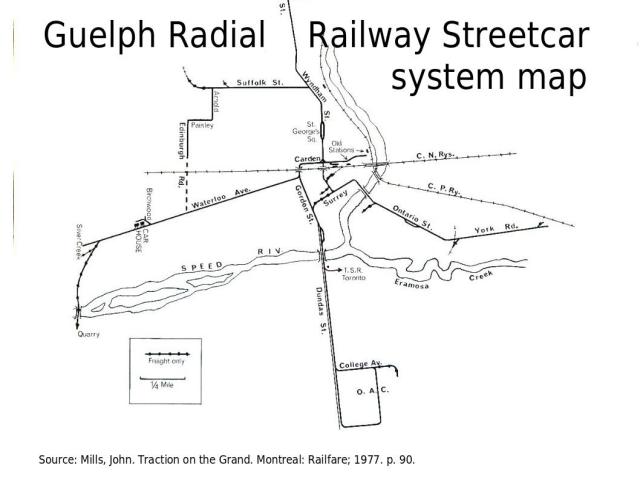
I would like to take you back for a moment to September 17th, 1895, the day the Guelph Radial Railway introduced 20 minute streetcar service to the city, based out of its main station on Carden St., where it connected to the Grand Trunk Western's and the Canadian Pacific's passenger services at what one might call a Transit Hub. This is a map of its service which ended in the early 1930s. We are almost back to this level of service.
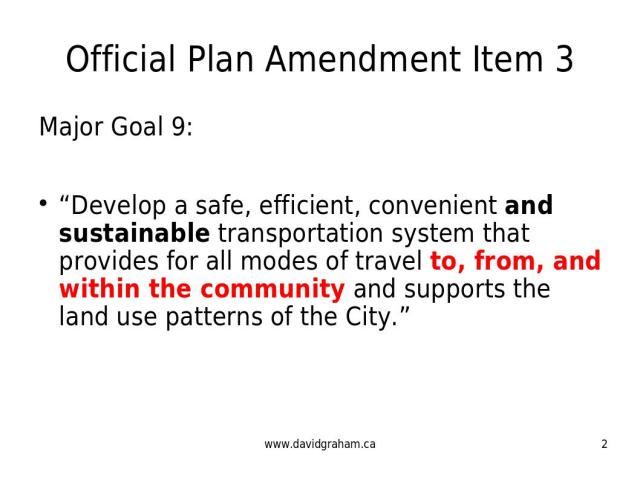
I come to you as a private citizen in support of the changes to major goal number 9 of the Official Plan, and to express my concern about the future of transit in Guelph specifically, and in Canada more generally. Ours may be the only country left on the planet still ripping out more railway tracks than we are putting in. What you do with this information will affect all of us for years to come.
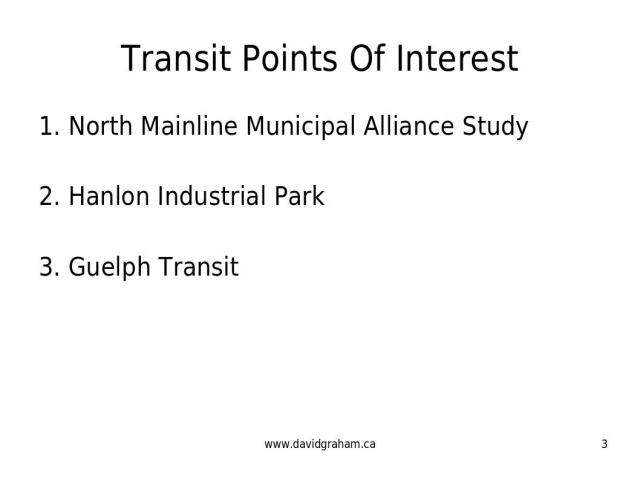
There are three major points I wish to express in relation to the new Official Plan. Firstly, I will draw your attention to the North Mainline Municipal Alliance study of 2006. Secondly, I would like to address a fundamental improvement that I would like to see in the creation of the new Hanlon Industrial park. Thirdly, I would like to propose some ideas for the future of Guelph Transit. From there, I will summarise what I have said and offer you some simple recommendations.
North Mainline Municipal Alliance: Business Case for Improved Rail Passenger Service - item 76k
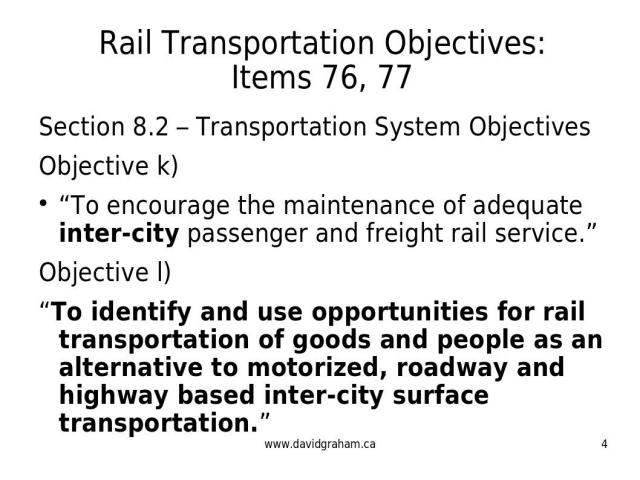
First and foremost, per item 76(k) of the amendment to our official plan, I plead with you not to forget about the North Mainline Municipal Alliance's study, presented to city council on July 17th, 2006 and not acknowledged in the amendments. The short version of this study is that, for the estimated 50 million dollar cost of the Clair Rd to College Hanlon "upgrades", we would have more extensive passenger train service in both directions connecting us to London and Georgetown and beyond.
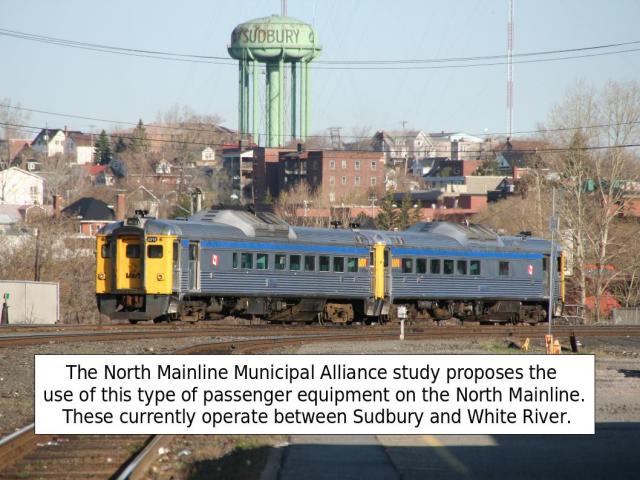
At a cost of some 58 million dollars, spread over three stages, the groundwork can be laid for self-propelled passenger coaches, currently awaiting purchase in New Brunswick, to operate here. This would substantially improve Guelph's inter-regional transit conditions. Please make the implementation of its recommendations of the highest priority.
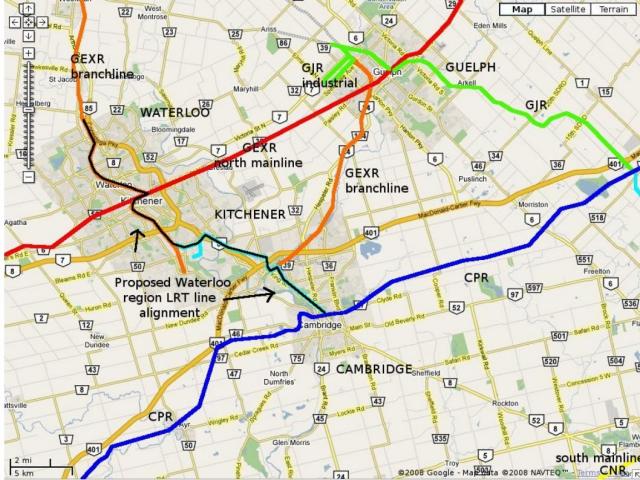
Waterloo Region is currently lobbying hard for the creation of an internal Light Rail Transit system, shown in black, Guelph should be lobbying just as hard to be connected to that system along the two different railway lines that directly connect Guelph to Waterloo's proposed LRT tracks. These tracks already exist as active freight lines.
The recently re-announced study for a Windsor-to-Quebec City high speed rail corridor will not come anywhere near Guelph, but it will become a major corridor to which we risk having no access. It will almost certainly use the established right of way from Toronto to London via Hamilton and Brantford along the 403. It will be our responsibility to ensure that we have access to this high speed corridor. Guelph risks being among the furthest points from this corridor of any major south-western Ontario city.
As the official plan moves forward into the age of true environmental awareness, Guelph has to consider options to assist in getting drivers off our roads, because the options for not driving will be, for the first time in generations, better than the options for driving. The North Mainline Municipal Alliance's study and Waterloo region's LRT proposal have the potential to go a long way to help.
Hanlon Industrial Park - items 77l and 105
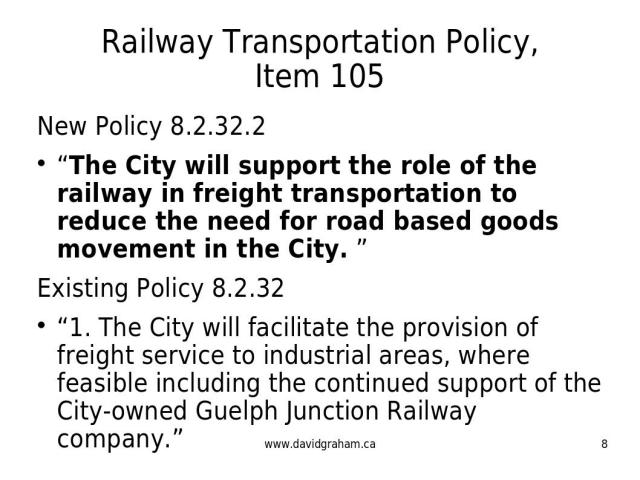
My second point is in reference to the ill-planned new Hanlon industrial park. I call your attention to item number 105 of the amendment relating to our support of the role of rail in moving our freight.
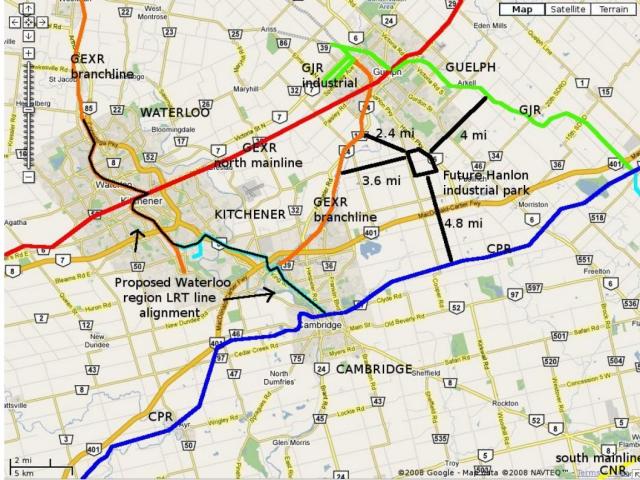
I have no objection to new industry coming to Guelph, but I have a big problem with building an industrial park within just 5 miles of not one, not two, but THREE different railway freight lines, as shown on this map, without so much as an industrial spur to coax businesses out of their massively subsidised trucks. One of these three railways, and perhaps the easiest one to connect to the park, is owned by the City of Guelph. The Guelph Junction Railway would allow more rail-using industry to move into Guelph in this new industrial park, reduce the number of trucks, and directly feed the revenue from the transportation of goods back into city coffers.
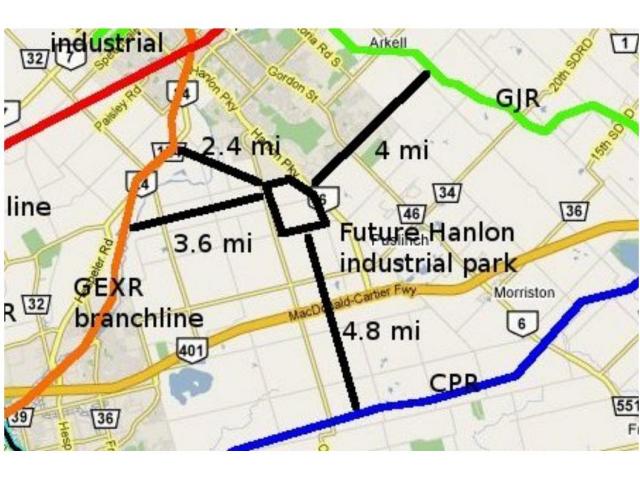
Building a new major industrial park under 5 miles from the Guelph Junction Railway to the east, Goderich-Exeter Railway to the north and west, and Canadian Pacific Railway to the south, without any rail service is simply irresponsible and should be remedied in the official plan.
It is also important to note that the possibility of adding rail service to the Hanlon industrial park, which will be on the west side of the Hanlon, will be severely endangered by the construction of the new Clair/Laird/Hanlon interchange if provisions are not made in that interchange to allow for a railway line to pass under or over the Hanlon. That industrial park with rail service would be meat for a facility like the long-rumoured Guelph food terminal or a new auto manufacturer as mused about in last Monday's Mercury editorial. Without it, we are saying that only truck-using industries are welcome in Guelph, and that the 401, not our railways, is our greatest transit asset.
Funding Guelph Parking through Guelph Transit - item 87
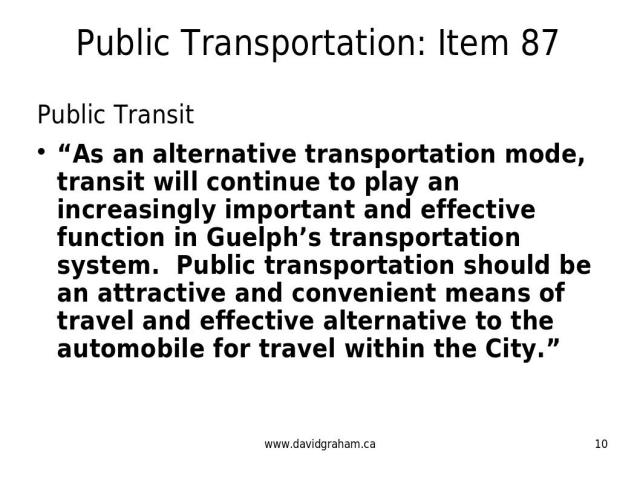
Thirdly, we must better fund Guelph Transit, per item 87. All the rail service in the world will be meaningless if residents do not have an efficient way of getting to it.
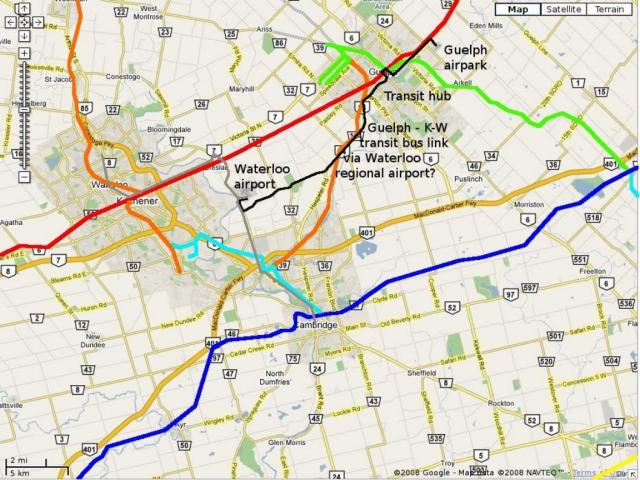
Efforts should also be pursued to connect Guelph Transit to Grand River Transit, perhaps by creating an interchange between the two at Waterloo regional airport in Breslau, with an airport-downtown-airport express on our end, and a downtown-airport-downtown express on theirs. This would allow people to easily get to our regional airports from any of Guelph, Kitchener, Cambridge, and Waterloo via their downtowns or from the train stations at Guelph or Kitchener, and to allow people to connect there to get between any of these locations.
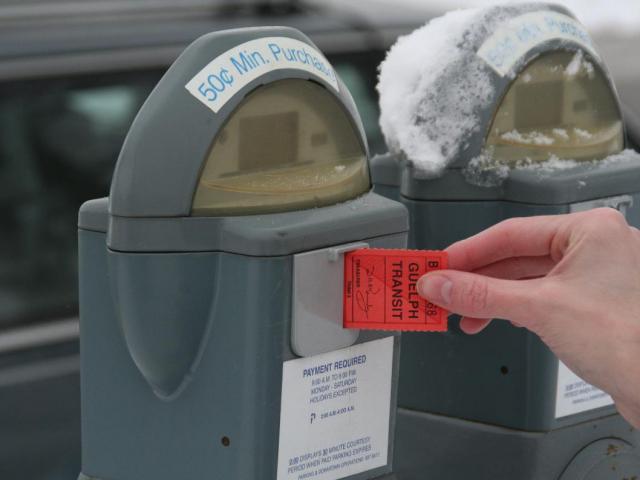
For Guelph Transit, perhaps a counter-intuitive solution to its funding, and to another problem currently facing Guelph, is to charge the equivalent of bus fare to park at any parking meter in the city, perhaps even some day at any business in the city with over, say, 100 parking spaces. This would serve to divert all parking metre revenue in the city directly to Guelph Transit, while sending a message to those parking that it will cost them a bus ticket whether or not they use the bus.
While the current pilot project to provide free two-hour parking downtown is good for local business in the short term, its high cost, and its effect of encouraging cars in the city is in direct conflict with the official plan. Left in place, over time, and coupled with our rising transit fares, Guelph will effectively be asking transit riders to fund downtown parking.
Rationale
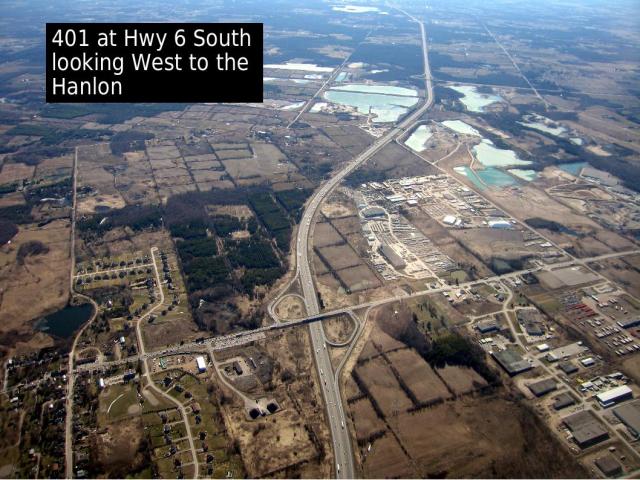
Ultimately, highways lead to more cars, and cars lead to more highways. By contrast, trains can simply be made longer. With every coach on a GO train seating 150 passengers, plus standing room, each GO train can remove as many as 2000 cars from the road.
Industrial parks lead to more trucks, and trucks too, lead to more highways. This, too, can be alleviated with the sensible use of our once mighty rail system.
Whether cars and trucks are still king in 50 years is not so much about how much oil we have as it is about how much leadership we have. Road vehicles will always be with us. Whether we drive them all ourselves, at low speed complaining endlessly about the high price of the era's fuel and the endless congestion, or we see traffic largely restricted to emergency vehicles, local deliveries, and transit services is entirely dependent on what decisions we make today.
As a driver, paving over the entire province of Ontario so I can drive anywhere in a straight line has its appeal, but as a thinker, I see that endless road construction has to stop. The 401 is about to be widened to 8, and within 5 years up to 10 lanes from Kitchener to Cambridge. At what point do we say it is simply too many? We have to consider options that will serve to assist in getting drivers off our roads by making the options for not driving better than the options for driving.
Conclusion
I will conclude by saying that I feel comfortable making these points to this city council as I feel we have the leadership here in this room to take these matters forward.
I ask you not to forget about rail and the North Mainline Municipal Alliance study when finalising Guelph's official plan. I ask you to work to see how Guelph can connect to Waterloo's proposed LRT system. Rail costs nothing compared to highways and is far and away the most environmental and economical solution to both our passenger and freight needs. It is also important to fund Guelph Transit to the highest level possible. Inter-regional, regional, and local transit, function best as one integrated package.
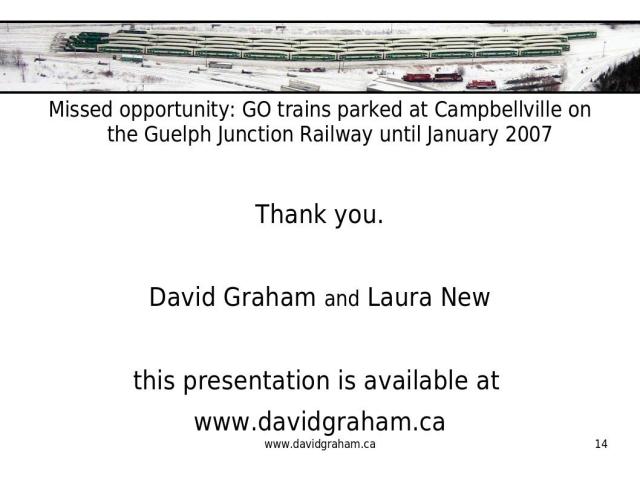
I look forward to the results of your deliberations.
Thank you.
guelph
presentations
transit
tv
1632
words - whole entry and permanent link. Posted at 02:57 on
February 04, 2008
The Evolution Of The Cost-Effective TrainCam
Recently, I incorporated a wireless camera into an HO scale 74' passenger car to make a TrainCam, and this is the story of its construction.
Lacking space to build a set in my rented single room, I built a simple 18" radius track on the carpet, going through the frame of my bed. On it, I added a short Amtrak train and watched it go in decidedly boring little circles. Not long after I started running the train, it derailed and clearly demonstrated why carpets are not the best place for model trains to be.
Meanwhile, upstairs in his room, one of my housemates had just bought a small wireless camera, battery pack, and receiver for a little over C$100 and was demonstrating its ability to broadcast conversations and images from as far as 200 feet away back to his computer screen, with the help of a TV capture card. It wasn't long before I started coveting the little camera and I soon bought myself one. It was not for the purpose of listening to my friends' conversations so much as it was to record the train as it chugged around the uneven little track on my floor."
It took me a few seconds to set up the little camera and immediately, my comically slow little trains which, when travelling at maximum speed, could easily be passed by a heavily-burdened pedestrian, began to look almost life-like. On my television screen I saw Amtrak engine 231 chugging toward me as I have so often at St-Albans station in northern Vermont. Following it were two streamlined phase III passenger cars and each, in turn, went around the corner as if on a real track.
Around the same time, I was able to move my track onto a 3'x5' desk, using blue-tack adhesive as a temporary track-bed.
The camera idea was working well. I felt like I was standing beside the tracks and the noise of the miniature train cars rumbling along the desk through the camera's microphone sounded nearly realistic, but there was something missing.
When I was in grade 3, the last train came to my home-town, a simple 20 car freight train hauling a giant transformer. I went to watch with my father as it waited for clearance to leave the station. Beyond the station, the tracks had already been lifted and sold to be reprocessed as razor blades. Standing on the platform looking intently at the train paid off, though, when every youngster's dream came true and the engineer invited me up into the engine while he waited, showing me all the controls and explaining how he needed someone to come up by car to tell him he could leave because we were out of radio range. Looking out the front of the train, I could see the tracks ahead and the elaborate set-up of switches, bells, signal lights, and level crossing signals.
I wanted to recreate that feeling with my simple model train and inexpensive wireless camera. It became my obsession to build a self-contained traincam that could record the tracks as it came and went, possibly even towed by one engine, recording another, giving a movie feeling. But I wanted to do something unique - I wanted to do it so I could publish basic steps for building one, and I wanted to make the whole thing as inexpensive as possible.
My first step was to figure out what rail-car to convert into my traincam. I decided that a dummy engine base with its large truck protruding would be ideal. The truck would allow the camera to better follow the angle of the track rather than the angle of the car. But the camera was too big. The eye itself is slightly wider than the car, and it had a base, battery box, and transmitter to contend with as well. Using a hacksaw and a variety of other tools not usually associated with delicate electronics, I disassembled the camera and extracted its motherboard, transmitter, and eye without damaging any of the wires or circuits. Using my favourite adhesive - blue-tack - (second, perhaps, to duct tape), I attached the camera eye to the front truck of the dummy engine, put the motherboard in the middle, supported it with two hair-elastics, and attached the transmitter to the rear truck. The camera's power source was a battery pack nearly three times the width of the track which had 4 AA batteries and a small circuit board. The power was sent to the camera via wires separated with a plug, and the wires added up to more than 6 feet in length.
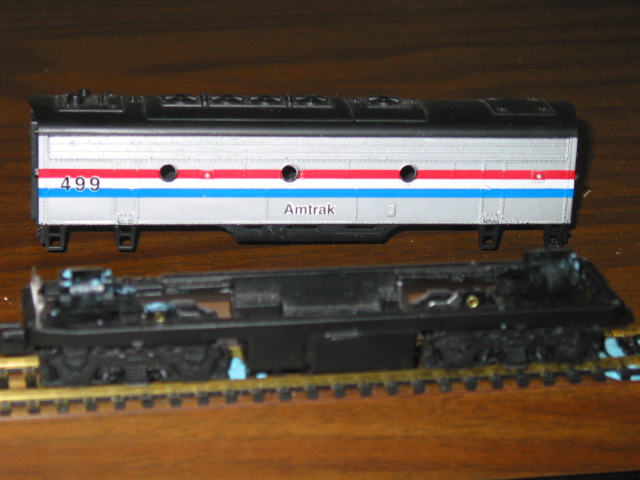
The dummy engine provided a wheel truck which protruded through the floor, allowing a camera to follow the track's, rather than the railcar's, angle.
Unperturbed, I took an old caboose, took part of the top off, and stuffed it full of wires. Next, I used a flatbed which had been part of my older brother's set at my grandparents' place when we were young and, again using blue-tack, attached the oversized battery pack to its surface.
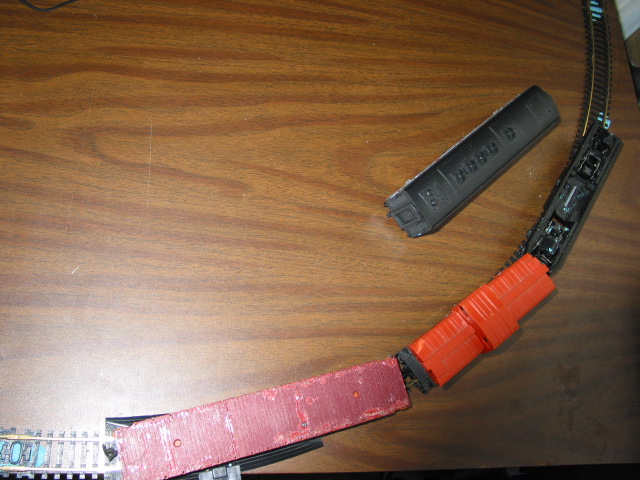
This is the base used for the original camera. Unfortunately no pictures were taken of it at the time it was used.
But all this led to a problem. If you've ever driven a car with a trailer, you know that reversing with a trailer is far more difficult than reversing without a trailer. If you add a second trailer, the vehicle becomes four times as hard to steer in reverse, and if you add a third trailer, the car becomes 16 times harder to reverse. On a train track, the problem is reduced by the metal guides which the cars are forced to follow, but any abrupt movement by an engine pushing three unbalanced cars attached together by stiff wires is very likely to cause a derailment. So the camera could only be pulled, and I found myself spending a good deal of time watching where I had been rather than where I was going, defeating the purpose of the entire exercise - namely to feel like I was watching out the front of a train.
To solve the problem I would need to do what I had originally set out to do - build the entire camera system into no more than one rail-car, and there had to be one more condition: the car could not exceed the length of an 85 foot car, in order to ensure that it could be run on nearly any HO gauge set-up. It also could not exceed the height of an auto-carrier excess-height car (anything less would not have been possible with the size of the transmitter) so it could run on any track with reasonable tunnel and bridge heights. The answer was a 74' Northern Pacific observation passenger car, made by Athearn, because that company's cars' covers detach from the base, giving me more room to work.
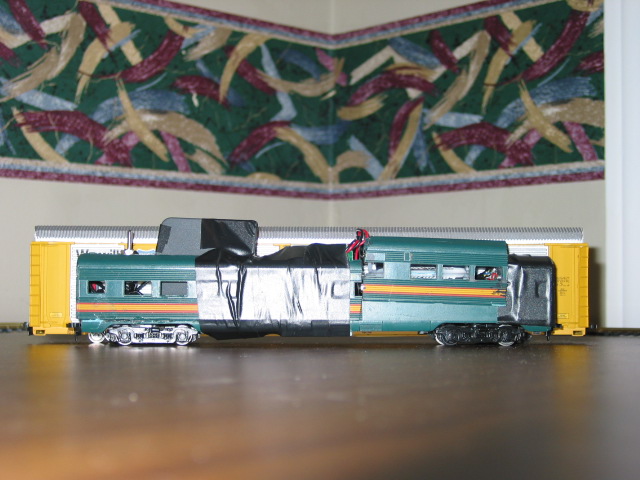
In the end, the traincam turned out to be slightly taller than an autocarrier, but was short enough and had a low enough centre of gravity to negotiate most corners.
There was still one more problem, though. The battery pack was too big to fit in anything short of a garden train, and it had a circuit board inside it, whose purpose I had not yet determined. My first thought was to put four AA batteries inside the car and attach them to a plug of the same type as that on the camera, but the circuit board stopped me.
Using a voltagemeter, it became apparent that the circuit board was a voltage multiplier, which increased the batteries' 6 volts to 24 volts. This gave
me five options:
- build my own circuit board with the same function
- use a second car and fill it with 16 AA batteries
- use 2 12V remote-control batteries
- disassemble the battery pack and use its circuit board
- run the camera off the track's power
Option 1 - building my own circuit board - was out of the question. I had neither the necessary experience nor the know-how to build my own voltage multiplier.
Option 2 - using a second car to hold loads of batteries - had some appeal to it; a model rail-car weighing that much would not derail if it was rammed by a real one, but the cost of 16 batteries and the extra space needed seemed prohibitive. Besides, I explicitly wanted to limit this project to a single car.
Option 3 - using two small 12-volt remote-control batteries - was a good idea. The logic seemed OK to me. I knew that two 12V batteries would cost me about $14 to replace and that they would have a shorter life-span than multiple AA batteries, but they were tiny and left lots of extra room in the car for the motherboard, wiring, camera, and transmitter.
Option 4 - disassembling the existing battery pack for its circuit board - was also a good idea, but I was concerned that I might damage the board while extracting it.
Option 5 - running the camera off of track power - sounded like the best idea. With nickel metal hydride or lithium ion rechargeable batteries (the type used in laptops), I thought that I could possibly keep enough charge to run the camera when the tracks were off, and have it constantly recharge when the tracks were on. But the problem lay in the fact that the camera ran at 24V and the track ran at between (-15V) and 15V, a circuitry nightmare for someone without the knowledge to build a simple multiplier.
I settled on option 3, which involved purchasing two small 12-volt batteries, and, believing I had solved all my design problems, took the cover off my observation car and began adding the camera, its motherboard, and transmitter. The camera fit nicely at one end of the car, but the motherboard and transmitter were too tall and could not be left like that. Realising that the car would probably be heavy enough with the camera, I took the ballast weights out of the bottom of the car, and the motherboard fit very well into to centre, where the base is lower than elsewhere. The transmitter also fit, though it exceeded the height of an auto-carrier excess-height car by a fraction of an inch. Everything up until this point was being held down with blue-tack.
Putting the motherboard in the centre allowed a tiny selector switch on it to be accessible from the side holding the camera. The switch allowed for choosing which channel the camera would use within the 2.4GHz band, and in turn would allow 4 different cameras of this type to operate in the same area at the same time.
In order to use the top of the car, I had to cut most of an inch off the front of the cover to allow room for the camera, and cut off the observation window and a strip of plastic most of the way to the opposite end of the car from the camera, where the motherboard and transmitter would be allowed to protrude, as well as a large un-train-like power switch. For power, I used a single AA battery holder cut in half and glued to the base with the two halves separated to be a little bit longer than it was originally intended. Then I added the two 12V batteries, put the cover on the car, and turned on the switch.
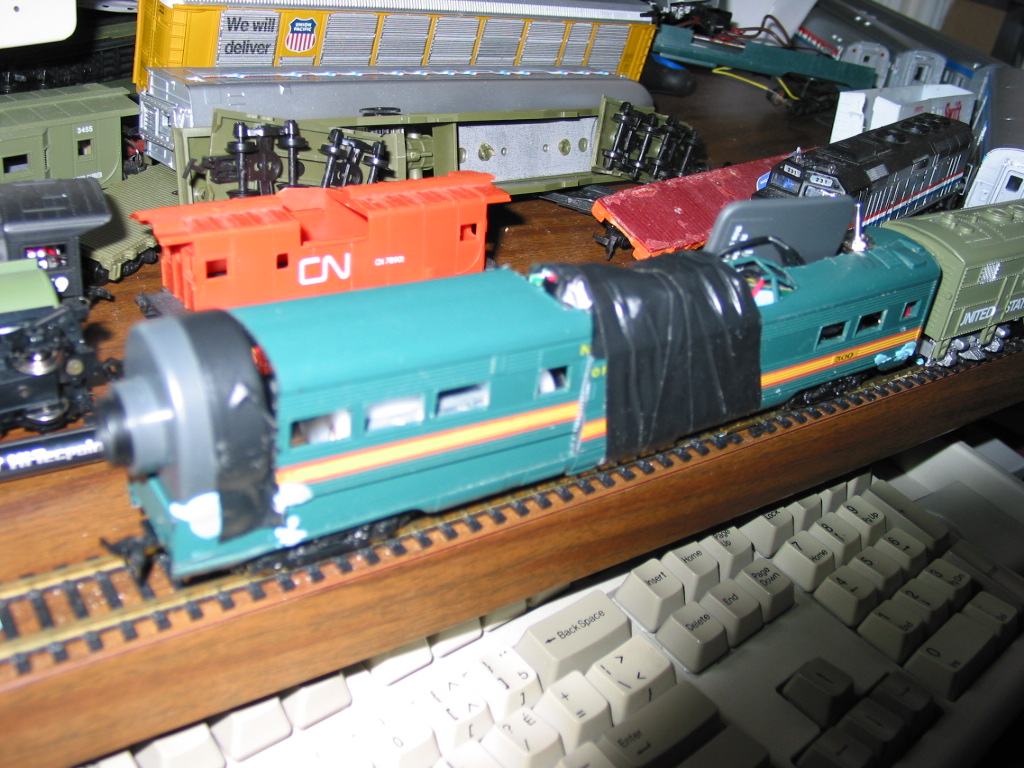
The original version of the self-contained traincam had a large camera head at the front and required a major section of the railcar's body to be removed from the front and top.
On my television screen was a nice view of the tracks looking forward from my traincam. I attached an engine to the back of it and turned the engine on, pushing the camera. It worked perfectly. My very own traincam was going happily around my miniature, undecorated set-up. I was excited.
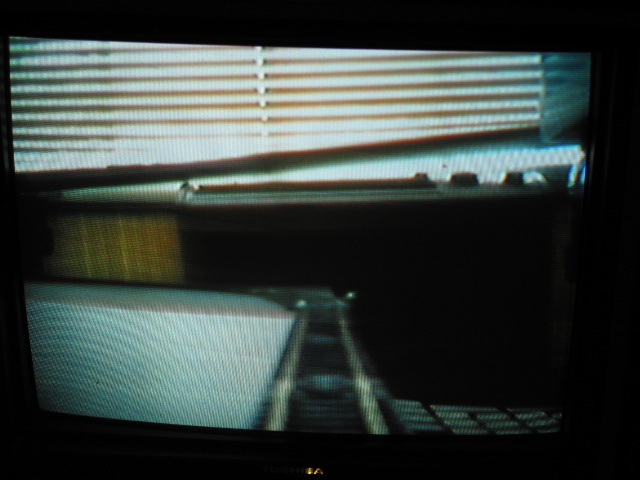
The image on the screen was exactly what I had hoped for.
I mentioned earlier that 12V batteries would probably have a shorter life span than multiple AA batteries, and as it happens, I was right. As the camera approached the end of its first lap, the television screen went fuzzy and then turned to blue. The batteries had lasted a total journey of nearly 14 feet in 15 seconds. My heart sank. My traincam would not make it around the first bend of any respectable set-up before running out of juice, so it was back to my list of options.
The logical thing to do with the failure of the 12V batteries was to go with option 4: disassemble my existing battery pack and remove its circuit board. That sounded nice in theory, but the inside of the traincam had very little room left, certainly not enough room to hold four AA batteries let alone a small circuit board and additional wires associated with another board.
In spite of myself, I disassembled the battery pack, carefully removing the circuit board with a large pair of pliers in a manner reminiscent of the way junk-yards recover engines from discarded vehicles. Having extracted the board, I cut the wire leaving the battery pack at the plug and I finally had my power solution -- with one problem. I still had to fit 4 AA batteries in the confined space of a one-inch wide train car with the added challenge of making them easy to replace without having to disassemble anything. In the true spirit of ruthless destructiveness, I carefully cut away a huge section of the frame and was able to fit four batteries between the camera and the motherboard, using the cut-away piece of frame as a battery cover. I then cut the wires to the glued-down base of the 12V battery holder and rewired the train to have an extra circuit board in its place, capable of multiplying 6V to 24V.
Having tested all the wires before reassembling the case, I was confident that the camera would work flawlessly and, using model cement, I glued the cover onto the base, covering all the circuitry and leaving only the batteries exposed. Using blue-tack, I attached the removed section of cover over the batteries and was amused by the yellow stripe on the side of the car being no longer quite so straight.
On to the next step: the test.
I turned the camera on, expecting to see the track show up on my television screen.
Instead, a visible spark, and a blue screen lacking only the familiar message "Fatal error" greeted me.
Removing the cover with the glue half-dried was an experience in itself, and when I finally did manage to get the traincam open, I found that the circuit board from the battery pack's negative wire, which I hadn't insulated, had made contact with the camera's motherboard, resulting in a short circuit and an unwelcome interruption in service. With a little electrical tape for the short circuit and all other exposed wires, it was time to add more glue and test the camera once again.
I attached the camera to a U.S. Army engine and turned the transformer on. The camera car very smoothly allowed itself to be pushed rapidly around the track. Holding my breath, I turned the camera on and let it go around the track once again. On my television screen I saw the tracks zip by, and the batteries even lasted for a while.
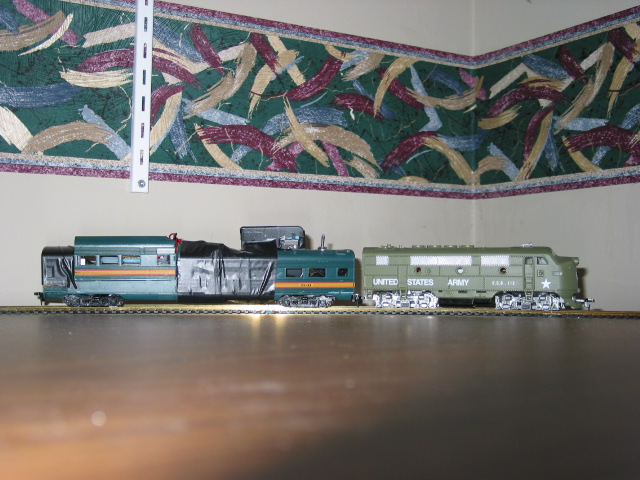
The US Army engine and traincam are viewed here in profile on my desk.
The next morning I turned the camera on, and it had no life. Some quick tests with the voltagemeter revealed that something had drained my batteries during the night. I'd have to disassemble it and figure out what was draining the batteries in my sleep.
I decided I would use the opportunity to add lighting to the camera. In the dark, such as in a tunnel or simply in an unlit room, there was no image.
With the help of a lighting kit, which consists of 2 small lightbulbs and some wires, I affixed a light bulb on either side of the camera lens.
This created a new problem, however, as the camera was too big for the lights. I would have to disassemble the camera head, too, and that meant cutting, stripping, and reattaching some extremely fine wires. Meanwhile my battery draining problem was forgotten.
I removed the screws holding the wheel truck in place under the camera and fed the wires for one of the lights down through the tiny hole. One of my lights, I decided, would be track powered. The other light would be attached to the battery pack and come on when the camera came on.
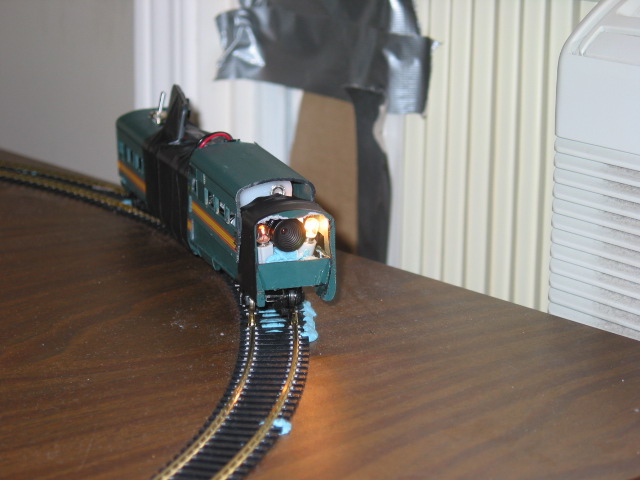
The two lights are clearly visible in the front of the traincam. On-board batteries power the one to the left, and the one seen to the right is powered by the tracks. The one powered by the batteries is dimmer than the one powered by the tracks as it is being connected to the camera's electrical system before the multiplier, resulting in a lower voltage -- and better power conservation to power the all-important camera.
With the now reduced camera with its exposed circuitry sitting in a bed of blue-tack near the front of the traincam, I was finally able to fit the lights in place, using still more blue-tack, on either side of the camera, behind the front ledge of the lens so that they would not overpower an image the camera tried to capture. Seeing that the camera and lights were all exposed to the elements, I began to glue back the front inch or so of the shell which I'd cut off to make room for the original design. This provided a shelter for the camera and lights in the event of a derailment (which could be catastrophic on my desk, as trains derailing have the annoying habit of plunging 2 feet to horrible destruction on the floor) and a way of focusing the light from the two lightbulbs forward, illuminating the view for the camera in the event that ambient light would not be strong enough. The track-powered light worked flawlessly. It was about time something on this camera did. In a dark room, the track-powered light at full power was strong enough to read by from more than a foot away.
The other light, the one attached to the internal circuitry of the camera, still posed a problem. The only wires that were not insulated, and so didn't involve a complete disassembly, were the connectors where the batteries made contact with the voltage multiplier. But that left a problem: as long as the batteries were plugged in, the light would be on. It would make my existing power-drainage problem a walk in the park by comparison.
My power-drainage problem? I had forgotten about that! Forgetting about the problem of the light draining the battery pack, I set back about my original task of fixing the power drainage. It wasn't long before I put 2 and 3 together and was pretty sure I'd come up with 5. My battery pack went straight to the multiplier, the multiplier then sent power to the switch and from there to the camera's motherboard. That meant there was only one place that could be drawing power: the multiplier.
I carefully removed the multiplier and all the wires from the guts of the traincam, and with wires hanging everywhere and blue-tack getting stuck to everything, I thoroughly examined the multiplier. What, I thought, could I do about this problem, without completely rebuilding the system?
It was simple. There was a tiny wire on the multiplier I'd previously ignored, and attached to it was a small switch. Obviously, that switch was not just an on-off switch for the camera: when on, the multiplier was draining power even if there was no draw on it.
With this piece of information I was able to kill two birds with one stone. I attached one of the battery-powered light's wires to the switch, and moved the switch to somewhere where I could reach it outside of the jumble of wires inside the traincam's shell. Using electrical tape and blue-tack, I affixed it to the transmitter antenna.
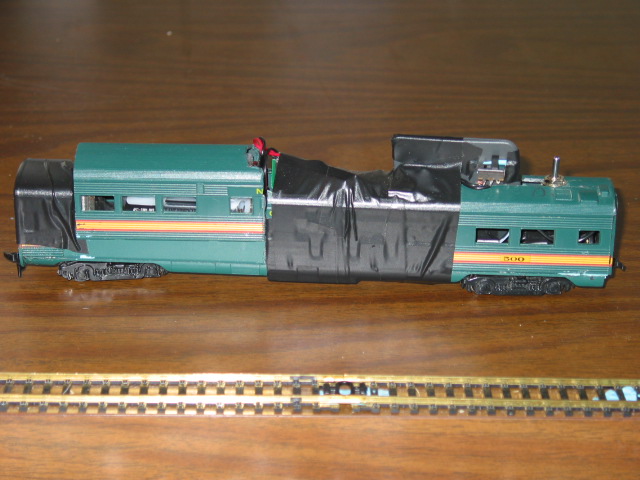
At the back of the car, two switches are visible. The large metal switch in the back was the original switch, and the smaller one attached to the transmitter is the multiplier switch.
With that solution in place, I installed fresh batteries, put all the innards back into the train's open hole, sealed it up with electrical tape, and tested it.
Now the natural assumption here is that it worked, and it wouldn't be a bad assumption. But it would be only half right.
I turned on the switch attached to the voltage multiplier, and the light on one side of the camera came on. That was a good start. I took a deep breath, and turned the camera switch on.
The audio static on my TV set disappeared, and I waited expectantly for the video static to do the same. I had sound but no sight. What good was a train camera that had sound but no sight?
I removed the battery section's cover, removed the battery pack, and unceremoniously squeezed all the fine wires I'd earlier stripped and spliced to get the camera out of its shell. Then I put the battery pack back in and the cover on.
The problem turned out to be a weight imbalance. The end of the traincam with the batteries was heavy enough to pave a road, but the other half of the car, which held only the switch, the transmitter, and some wires, was too light and could easily be imbalanced and leave the track. With the help of a pair of container weights and some more electrical tape, I was able to easily remedy this last problem by strapping the weights under the car and holding them there with the tape.
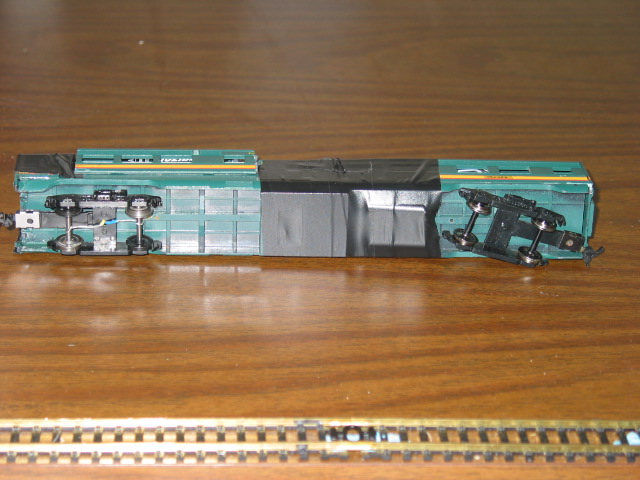
Near the back wheels, visible to the right, a bulge hides two heavy pieces of metal known as container weights. Under the camera at the back (to the left in the photo), the wheel truck can be seen to have two wires, from which power for the camera's light is collected.
At long last, I had a traincam that worked. A comparable traincam on-line would have cost a minimum of US$360, approximately $550 Canadian, and would still have required a train car to mount it in and some assembly. Purchasing a traincam built into a railcar cost even more.
This cost-effective self-contained traincam was completed for an estimated cost of C$170 (approximately US$115) and uses the following components:
(Prices are approximate and in Canadian currency)
- X-10 Wireless 2.4GHz wireless camera receiver (model VR31A) (attached to VCR)
- X-10 Wireless 2.4GHz wireless camera and components (model XC10A) (camera, motherboard, transmitter)
- X-10 Wireless camera battery pack components (model ZB10A) (voltage multiplier) (all camera components C$118)
- Athearn Northern Pacific 74' observation car (C$20)
- Small screw-on electric switch (C$2)
- 4 AA batteries (C$7)
- 2 small lights (C$5)
- Container weights (C$5)
- 2 AA battery holders with 9V battery style plugs (C$5)
- 2 9V battery style wires and plugs (C$2)
- Electrical tape (C$1)
- Model cement (C$2)
- Blue-tack (C$3)
- Wires (scavenged from 6' of wire attached to camera) (C$0)
Originally posted on Slashdot 2002-12-03. Reposted here 2019-11-21.
presentations
transit
3969
words - whole entry and permanent link. Posted at 02:21 on
December 03, 2002
(RSS) Website generating code and content © 2001-2020 David Graham <david@davidgraham.ca>, unless otherwise noted. All rights reserved. Comments are © their respective authors.













































